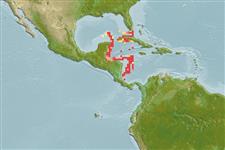Common names from other countries
>
Ophidiiformes (Cusk eels) >
Ophidiidae (Cusk-eels) > Ophidiinae
Etymology: Lepophidium: Latin, lepus, leporis = rabbit + Greek, ophis = serpent (Ref. 45335).
More on author: Robins.
Environment: milieu / climate zone / depth range / distribution range
Ecologie
marien bathydemersaal; diepte 180 - 485 m (Ref. 34024). Deep-water; 25°N - 10°N, 90°W - 80°W (Ref. 91765)
Western Atlantic: apparently restricted to the deep bank area east and northeast of Nicaragua and Honduras in the western Caribbean Sea and north of the Yucatan Peninsula in the southern Gulf of Mexico; not in the eastern Gulf of Mexico.
Grootte / Gewicht / Leeftijd
Maturity: Lm ? range ? - ? cm
Max length : 27.3 cm SL mannelijk / geslacht onbekend; (Ref. 91765)
Korte beschrijving
Determinatiesleutels | Morfologie | Morfometrie
Dorsale zachte stralen (totaal) : 140 - 147; Anale zachte stralen: 120 - 125; Wervels: 80 - 83. This species is characterized by the following: usual number of vertebrae, precaudal 14-15, caudal 65-67, total 81-82 (80-83); usual number of fin rays, dorsal 142-145 (140-147), anal 120-125, pectoral 22-23); pyloric caeca usually 3 (rarely 4), 2 (rarely 3) in a single whorl, 1 in 2nd tier; first gill arch with rudimentary rakers 4 (rarely 3) on the upper arm, 8 developed (rarely 7) developed rakers on the lower limb, 0-3 (usually 0) rudimentary rakers anteriorly on the first arch; total rakers 12 (usually 11-14); dorsal-fin origin between neural spines 4-5 (11 specimens) or 5-6 (6 specimens) (Ref. 91765).
Rare species (Ref. 34024). Reproductive strategy possibly similar to other members of this family featuring oviparity, with oval pelagic eggs floating in a gelatinous mass (Ref. 205).
Levenscyclus en paargedrag
Maturities | Voortplanting | Spawnings | Egg(s) | Fecundities | Larven
Robins, C.R., R.H. Robins and M.E. Brown, 2012. A revision of Lepophidium (Teleoastei, Ophidiidae), with descriptions of eight new species. Bulletin of the Florida Museum of Natural History 52(1):1-94. (Ref. 91765)
Status op de Rode Lijst van het IUCN (Ref. 130435)
CITES (Ref. 128078)
Not Evaluated
Gevaar voor de mens
Harmless
Gebruik door de mens
Tools
Speciale rapporten
Download XML
Internetbronnen
Estimates based on models
Preferred temperature (Ref.
115969): 13.8 - 20.6, mean 17.7 (based on 7 cells).
Fylogenetische diversiteitsindex (Ref.
82804): PD
50 = 0.5000 [Uniqueness, from 0.5 = low to 2.0 = high].
Bayesian length-weight: a=0.00102 (0.00046 - 0.00225), b=3.06 (2.88 - 3.24), in cm Total Length, based on all LWR estimates for this body shape (Ref.
93245).
Trofisch niveau (Ref.
69278): 3.6 ±0.7 se; based on size and trophs of closest relatives
Weerstandsvermogen (Ref.
120179): Gemiddeld, minimale populatieverdubbelingstijd 1,4-4,4 jaar (Assuming tmax>3).
Fishing Vulnerability (Ref.
59153): Low vulnerability (23 of 100).
